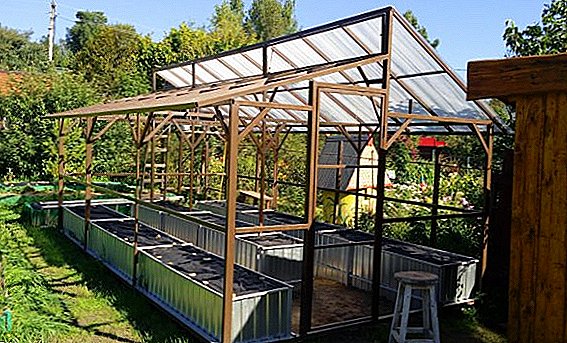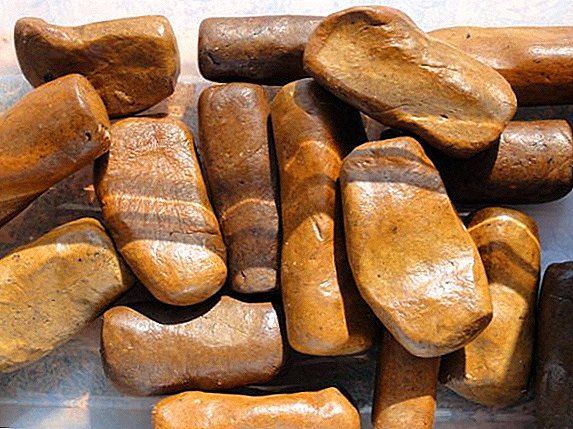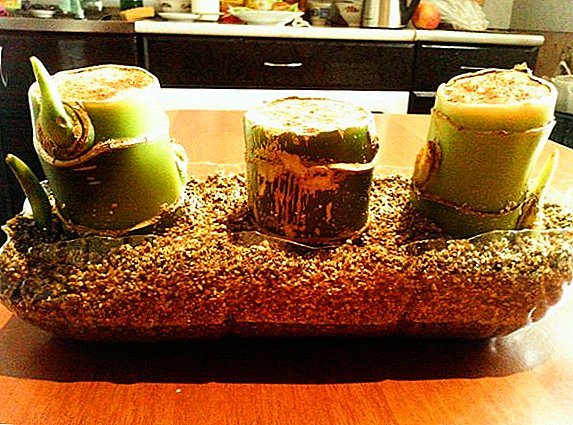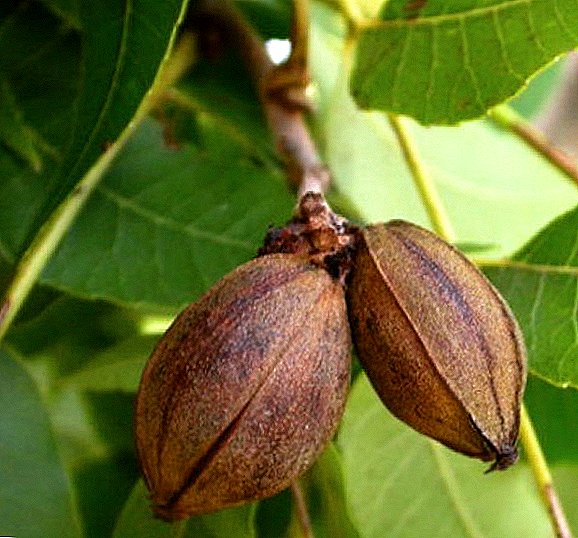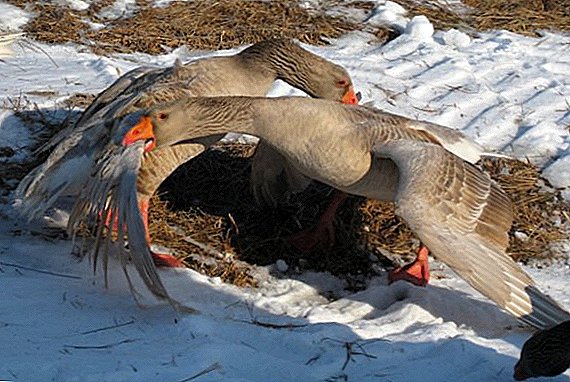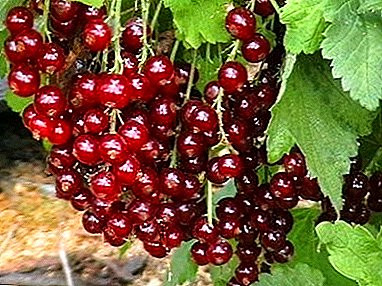
Red currant differs from black not only in color and taste, but also in the characteristics of agricultural engineering and fruiting.
Currant Red Andreichenko possesses many unique properties.
Her berries, leaves and shoots are used in traditional medicine.
This variety is perfect for processing on jelly and jam, and is often consumed fresh.
Description variety Andreichenko
Bush height of 1-1.5 m, not very sprawling, rounded, densely leafy. The shoots are rather thick, strong, straight, dark orange in color, smooth, dull, with gray-green tops.
Leaves five-pointed, small, dark green, slightly wrinkled, glossy, hairy underneath.
Berries pretty large, weighing 0.5-1 g, bright red, round, assembled in a small dense brush.
At the ends of the brush the berries are smaller, ripen in unison, they do not crumble when overripe. The flesh is very juicy, tasty, sweet, with a little sourness and large seeds. The skin is thin, but durable. It is transported well, but stored for a short time, about 2 weeks.
A photo




Breeding history and breeding region
This variety appeared in the early 50s. last century, as a result of random pollination varieties of the Red Cross. Breeders of the Novosibirsk Experimental Station I.V. Shpileva, D.A. Andreichenko and A.I. Degtyarev.
The variety was zoned in 1987 in the Ural, Mid-Volga regions and Siberia. This is very winter hardy variety, and thanks to this, it is grown on the territory of the entire former USSR. This variety has gained the greatest popularity in regions with an unstable climate, and is often found not only in Russia, but also in Belarus and the Baltic States.
In these regions, not only red currants are grown in gardens, but also black ones, such as Bagira, Belorusskaya sweet, Grossaya, Gulliver and Dachnitsa varieties.
Specifications
The variety is mid-season. Full ripening of berries occurs in the middle of July, but they can stay on the bush for about a month.
Fruit bush begins at 2 years after disembarkation. This is a very fruitful variety, with good care from one bush can collect up to 6 kg of berries.
In addition, the variety has good resistance to frost. At the beginning of flowering can withstand even significant frost, without damaging the buds and shoots. Self-fruited variety and does not require additional pollination. Berries are great for processing and for consumption of fresh.
From the berries of this variety they cook excellent jam, especially in combination with apples of the following varieties: Golden Summer, Malt Bagaevsky, Mantet, Bolshaya Narodnoe, Medunitsa, Elena and Daughter of Melba.
Planting and care
Landing place should be well lit, with low groundwater levels, protected from strong cross-winds. The variety is not afraid of cold weather, but branched shoots at the base of the bush can break out from the squall wind. The plot should be flat, not low, without shading.
 The best time to land this variety will early autumn, end of September. When planting several bushes, the distance between them should be at least 1.5 m.
The best time to land this variety will early autumn, end of September. When planting several bushes, the distance between them should be at least 1.5 m.
Prepare the soil in advance.
About a month before planting, the site is well dug up, weeds are removed, especially wheat grass and sow thistles, and organic and mineral fertilizers are applied: 5-6 kg of rotted manure or compost, and 1 tbsp. l potassium sulfate and superphosphate per square meter. m
If the soil is acidic, then it is necessarily lime.
2 weeks before planting, you can dig a hole, 50 * 50 cm in size. The prepared hole for 2/3 of its volume is filled with a mixture of top layer of earth, 2 compost or humus buckets, with the addition of 3 tbsp. l superphosphate, 2 tbsp. l potassium sulfate and 0.4 kg of wood ash. From above pour a thin layer of clean, sifted earth, pour water well and start planting in 2-3 days.
Shrub gently placed in a prepared pit and buried, tightly tamping the soil. Currant prefers a slightly buried, slanting fit, for better root development. After planting around the plant make a deep hole, well watered and mulched with a thick layer of peat or humus. Immediately, post-plant pruning is carried out: all branches are pruned, leaving a length of 10-15 cm. Despite the frost resistance, in the first winter after planting, the young bush is carefully tied and wrapped.
First three years care red currant consists in watering, weeding and loosening the soil and timely fertilization. In early spring, you can feed the bush with organic (6-7 kg of humus per square meter) and mineral (20 grams of urea and potassium sulfate and 100 grams of superphosphate per square meter) fertilizers. Under the winter only organic fertilizers are applied.
At the age of four years and older, the amount of fertilizer increases: 10 kg of humus, 30 grams of urea and potassium, and 100 grams of superphosphate per square meter. m in spring. In addition, fruiting plants make additional feeding, at least 4 times during the growing season.
First such top dressing spend before flowering, the second - at appearance of ovaries, after 2 weeks - the third and after harvesting - the fourth. For the first three, you can use special complex mineral fertilizers for berry crops. For the fourth, superphosphate and potassium sulfate (2 tbsp. Per bucket of water) would be better.
Very important and foliar dressing. It is best to spend them during flowering and during the formation of ovaries.
For this you can use growth stimulants and fruit formation. It is better to carry out such treatment in dry weather, in the early morning or in the evening.
Red currant needs regular watering, especially in dry and hot weather. Particular attention is paid to watering during the period of the first berries and after harvesting. The variety of currant Andreichenko is quite drought-resistant, but with a lack of moisture, the berries become small, dry, and the yield drops sharply.
In addition to the planting, they regularly carry out the formative and rejuvenating pruning of the bush. You can spend it both in spring and autumn. For 2-3 years after planting, the first formative pruning is carried out: all branches weakened and growing close to the ground are removed, leaving 4-5 strongest.
It is impossible to shorten the branches - this may significantly reduce the harvest next year.
Anti-aging pruning begin 7 years after planting. All unproductive old branches are cut out, replacing with new, young shoots. Timely pruning and proper care of red currants can significantly reduce the risk of disease.
Diseases and pests
Among the many advantages of the variety Andreitschenko red currant can be identified and several deficiencies: susceptibility to anthracnose and gall aphids.
 Anthracnose currant is expressed in the appearance on the leaves of small reddish dots. They quickly grow, merge and cause premature drying and falling leaves. Anthracnose shoots can also be affected. The most favorable conditions for the appearance of the disease are high humidity and warm weather.
Anthracnose currant is expressed in the appearance on the leaves of small reddish dots. They quickly grow, merge and cause premature drying and falling leaves. Anthracnose shoots can also be affected. The most favorable conditions for the appearance of the disease are high humidity and warm weather.
To combat this disease, in the early spring, the bush is treated with copper sulphate or nitrafen solution. The second treatment is done before flowering, using 1% colloidal sulfur. After 10-12 days - the third. The last spraying is carried out after picking berries using 1% Bordeaux liquid.
Among garden diseases, anthracnose, bacteriosis, chlorosis, rubella and bacterial carcinoma are most prevalent. You can get acquainted with the measures of their prevention in the articles of our site.
Sometimes grade Andreichenko may be attacked by leaf aphids. You can see its larvae on the underside of the leaf, where small red swellings form. Damaged leaves dry quickly and fall off.
As methods of struggle, in the early spring, the bush is treated with karbofos (40 grams per bucket of water). Spraying the affected plant with a solution of soap or garlic extract helps well. You can use pollination tobacco dust or cinnamon. All affected leaves and shoots must be cut and burned.
To avoid the attack of this pest, it is desirable to plant several beds of garlic or tomatoes near the currant bush. It is also necessary to constantly loosen the soil, clean up the fallen leaves and carefully dig the ground in the fall.
Variety of red currant "Andreichenko" has a lot merits:
- high yield;
- great taste;
- good presentation;
- winter hardiness;
- precocity.
Disadvantages very little:
- poor resistance to anthracnose;
- can sometimes be attacked by leaf gallic aphids.
Red currant "Andreichenko" perfect for planting at their summer cottage, and with proper care will give regular high yields.
You should also pay attention to such varieties of red currants, as Natalie, Jam and Beloved.


